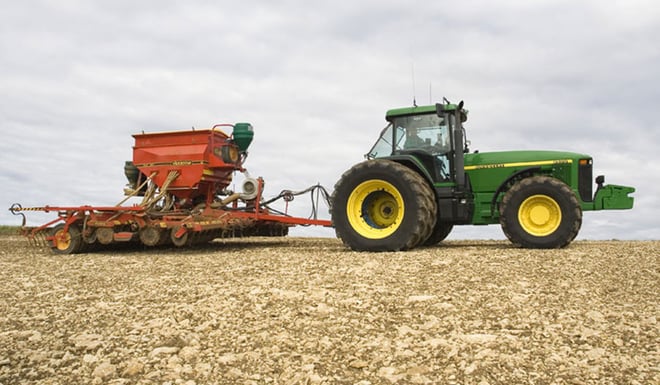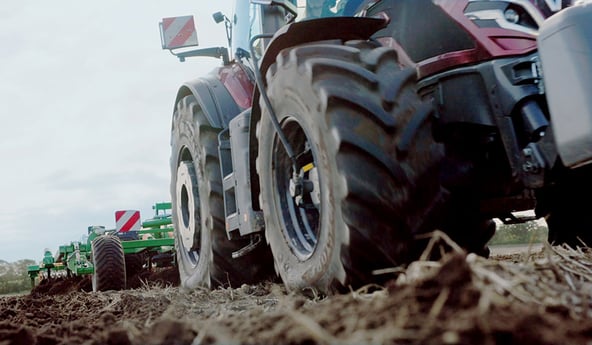Soil compaction is one of the major factors in the deterioration of agricultural land (after hydraulic erosion).

Interview with Hubert Boizard - INRA
Hubert BOIZARD managed the Agro Impact research unit at INRA in Laon-Estrées Mons (France). He took part in and coordinated a great deal of research work including soil compaction studies.
We also compared two types of soil preparation work: with ploughing or with ground preparation reduced to 5-6 cm in depth. On these systems with contrasting risks of compaction, we sought to understand the evolution of the soil structure following ploughing or no-till ground preparation work. This study was the basis for our research work.
Today, work on modelling the structural state of the soil continues at INRA in Orleans. Foreign research teams are also working a great deal on soil and sub-soil compaction issues in Denmark, the Netherlands and Switzerland.
Differing soil compaction risk levels

The load factor is very important in assessing the risk of soil compaction. With the same tractor tyre, if the load varies, the soil footprint is not the same.
There are two possible cases:
- “Light” work: at the time of soil preparation and planting. For these activities, the load per axle is not very high. It is possible, with low pressure tyres inflated to 0.8 or even 0.6 bars, to limit soil compaction in many different degrees of wet conditions.
- “Heavy” work: at the time of the harvest. For these activities, the size of the harvesting machines has increased considerably and, as a result, so has the load per tyre. Although wide, efficient tyres, with a large load bearing surface to spread out the pressure, make it possible to reduce surface compaction, the risk of deep soil compaction is high whenever the ground is wet. This is often the case for late harvests starting from the month of November. It may therefore be important to think about the date on which you start work on a piece of land. Lastly, the texture of the soil should be taken into account. With no tilling of the ground or at the level of the sub-soil, clay loam soils that are compacted by harvesting machines in wet conditions will regenerate more rapidly than sandy soils as clay soils have a capacity to fissure rapidly as a result of the climate.
Depending on the cropping systems adopted, the risk of soil compaction varies. With a cereal cropping system, it is limited: at harvest time, a combine harvester with hopper emptying at the edge of the field only impacts 15% of the plot. This surface area increases in a cropping system with fodder maize where the passage of the silage harvester is combined with a tractor trailer. In a beetroot cropping system, the surface area impacted may be up to 100% of the plot of land when an integral beet harvester is used. In addition, the combination vehicle is heavy, and the soil is often wet. Soil compaction then goes deeper, more than 30 cm below the surface.
What are the solutions to avoid compaction?
The increasing recourse to no-till farming in recent years must lead to fresh thinking. With no tillage, the regeneration of the structure is slower. As a result, the risk of compaction must be limited as much as possible, for example when harvesting cereal by emptying the hopper at the edge of the field during a wet summer. Occasional decompaction may also be necessary.
New solutions must also be sought, such as:
- “Controlled Traffic Farming”, where compaction is limited to the paths followed, which can be decompacted if necessary.
- Sowing using the StripTill technique together with a RTK guidance system also helps to preserve the soil. The problem is that the RTK can be used in cereal growing areas but not in beetroot growing areas because of the machines used.
Initiate discussions on the size of the machines with the manufacturers
The machines used in farming are increasingly heavy for work output and organisation reasons: in the long-term, this is not the right solution.
We need to try and reduce the load per tyre.
We are warning equipment manufacturers about the risk of deep compaction with the increasing weight involved in harvesting operations. But it is difficult to act on certain equipment, in particular the integral beet harvester. This would require rethinking the weight distribution between the harvest and the transport of the beetroot.
During spraying operations, with narrow tyres, soil compaction is greater but localised. This type of activity is not a major problem.
Improve farmer awareness of the risks of compaction
In the field, farmers are more or less aware, depending on their type of soil and cropping systems. Certain are aware of the issues relating to load and working in wet conditions, but more often than not, it is the organisational aspects of the activity which dictate the choice of equipment.
Generally speaking, the soils we have in France are sensitive to compaction and the number of farms turning to no-till farming is increasing.
The farmer needs to consider his soil’s capacity to regenerate. Compaction linked to tractor tyres on the surface of the soil can be corrected rapidly by decompaction.
Deeper down, it is the action of earthworms and the climate which will encourage regeneration.
The presence of earthworms will enable the creation of vertical tunnels which are important for good water infiltration and root systems.
The type of soil is also a key point: sandy soil regenerates slower than clay soils and therefore requires more frequent soil preparation.
The bridgestone-agriculture.eu blog is written by agricultural tyre experts who are available to provide you with the advice you need to maximise your productivity (How to ballast your tractor tyres - Technical data for agricultural tyres - Agricultural tyre performance - Pressure advice for agricultural tyres - Soil compaction solutions - Sprayer tyre pressure, etc.)
To take it a step further and increase the profitability of your farm, the agricultural tyre experts provides a free, highly detailed eBook which explains the essential role of the agricultural tyre in your productivity.
Most people who read this article have also read some of the following articles:
- 9 major points on soil compaction linked to tractor tyres
- What you need to know about soil compaction caused by your tractor tyres
- Protect your soil during harvest for successful sowing in the future
- How to reduce soil compaction after harvesting?
- What are the consequences of the soil compaction caused by my tractor tyres?
- 3 soil conditions to understand to avoid compaction by your tractor tyres
- What type of farming tyre is best for preventing ruts?
This information is intended only to make you aware of the technical and functional aspects of agricultural tires and their use. It does not allow you to make a judgment or a definitive conclusion on a given problem. Only your agricultural tire expert is able to make a technical assessment and take a final decision, case by case.
Leave a
commentary
Your email address will not be published.
Required fields are indicated with *








